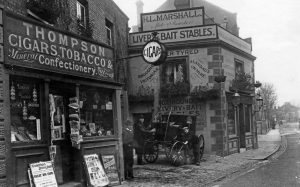Putney village, originally clustered around the church near the bank of the River Thames, developed very rapidly during the nineteenth century. In 1849 it was said to be only partly paved – although as early as 1656 thirteen parishioners of Putney petitioned Cromwell to be allowed to pave the High Street, which they said was long and broad and could not be made by gravelling.
The westward continuation of Putney High Street, which lies at right angles to the river, is called Putney Hill, and ascends towards Wimbledon Common. High Street is crossed above Putney station by Upper Richmond Road, which leads from East Putney station to Sheen and Richmond, being joined at Barnes Common by Lower Richmond Road.
East Sheen along the road from Putney became a manor in its own right around 1500. East Sheen village was centred around Milestone Green, which lay where Upper Richmond Road now crosses Sheen Lane. The village had only 26 houses in 1617.
Around the road before urbanisation and after enclosure were extensive market gardens, fields and orchards. By the early 1920s most of the area was built up and shops along Upper Richmond Road were created at East Sheen.
1930s housebuilding filled the remaining gaps south of Upper Richmond Road.
139 Upper Richmond Road is the location of Lime Grove, the birthplace of 18th century historian Edward Gibbon. His most famous work is ’The History of the Decline and Fall of the Roman Empire’ (published between 1776 and 1788).
 Horses and carriages would have been hired from this stable in Upper Richmond Road (1897).
Horses and carriages would have been hired from this stable in Upper Richmond Road (1897).
Picture: Wandsworth Museum
